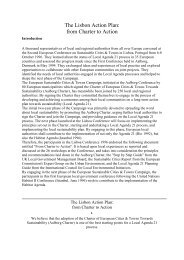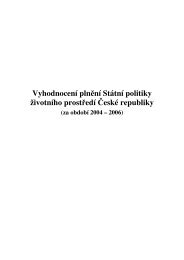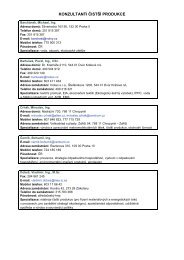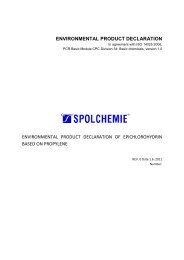Environmental Technologies and Eco-innovation in the Czech ...
Environmental Technologies and Eco-innovation in the Czech ...
Environmental Technologies and Eco-innovation in the Czech ...
Create successful ePaper yourself
Turn your PDF publications into a flip-book with our unique Google optimized e-Paper software.
Biological waste water treatment may be divided <strong>in</strong>to processes stimulat<strong>in</strong>g <strong>the</strong><br />
natural conditions (earth filters, root treatment plants) or controlled processes<br />
tak<strong>in</strong>g place <strong>in</strong> reactors. The treatment methods <strong>in</strong> reactors may be fur<strong>the</strong>r divided<br />
<strong>in</strong>to processes with microorganisms <strong>in</strong> suspension (activation) <strong>and</strong> <strong>in</strong>to processes<br />
with sessile microorganisms (spr<strong>in</strong>kl<strong>in</strong>g biological columns, rotary disc reactors). We<br />
can still divide waste water biological treatment <strong>in</strong>to reactors accord<strong>in</strong>g to whe<strong>the</strong>r<br />
<strong>the</strong> microorganisms ensur<strong>in</strong>g <strong>the</strong> treatment process require <strong>the</strong> presence of oxygen<br />
(aerobic conditions) or whe<strong>the</strong>r <strong>the</strong>y can work without <strong>the</strong> presence of oxygen<br />
(anaerobic conditions). Anaerobic waste water treatment methods are ma<strong>in</strong>ly used<br />
for <strong>in</strong>dustrial waste water with high organic substance concentrations, while aerobic<br />
treatment methods with <strong>the</strong> microorganisms <strong>in</strong> suspension are used <strong>in</strong> <strong>the</strong> majority of<br />
cases for municipal waste water treatment.<br />
The basic pr<strong>in</strong>ciple of treatment is <strong>the</strong> formation of activated sludge 10 aerated <strong>in</strong><br />
activation tanks. The microorganisms <strong>in</strong> activated sludge make use of <strong>the</strong> <strong>in</strong>dividual<br />
components of <strong>the</strong> waste water for <strong>the</strong>ir life <strong>and</strong> growth, <strong>and</strong> thus <strong>the</strong>y remove <strong>the</strong><br />
pollut<strong>in</strong>g components from <strong>the</strong> waste water – <strong>the</strong>y clean it. A biological treatment<br />
plant consists of an aeration tank <strong>in</strong> which <strong>the</strong> process of waste water treatment with<br />
simultaneous activated sludge production takes place <strong>and</strong> a f<strong>in</strong>al settl<strong>in</strong>g tank where<br />
<strong>the</strong> treated waste water <strong>and</strong> <strong>the</strong> activated sludge are separated from each o<strong>the</strong>r by<br />
sedimentation. The treated waste water flows from <strong>the</strong> biological treatment plant <strong>in</strong>to<br />
a recipient or it may be reused. The activated sludge thickened through sedimentation<br />
is returned back <strong>in</strong>to <strong>the</strong> activation tank (returnable activated sludge). Because over<br />
course of treatment <strong>the</strong> activated sludge concentration <strong>in</strong> <strong>the</strong> tank <strong>in</strong>creases (based on<br />
nutrients be<strong>in</strong>g constantly brought <strong>in</strong> with <strong>the</strong> waste water, <strong>the</strong> microorganisms grow<br />
<strong>and</strong> reproduce), it is necessary to regularly draw off a part of <strong>the</strong> activated sludge (<strong>the</strong><br />
excessive activated sludge) from <strong>the</strong> system.<br />
The issue of remov<strong>in</strong>g specific substances <strong>in</strong> <strong>the</strong> water has been ga<strong>in</strong><strong>in</strong>g greater<br />
significance, such as detergents, syn<strong>the</strong>tic dyes, heavy metals <strong>and</strong>, last but not<br />
least, <strong>the</strong> remnants of pharmaceuticals, steroids <strong>and</strong> hormones. These substances<br />
are not removed to a sufficient extent <strong>in</strong> common municipal waste water treatment<br />
plants. For this reason, biodegradation properties of o<strong>the</strong>r organisms are be<strong>in</strong>g<br />
searched for that would remove <strong>the</strong>se special substances from waste water. Today,<br />
experiments with some cultures of lign<strong>in</strong>olytic fungi 11 , which have <strong>the</strong> capacity to<br />
10 activated sludge – a mixed bacterial culture possibly also conta<strong>in</strong><strong>in</strong>g o<strong>the</strong>r organisms such as fungi, moulds, yeast <strong>and</strong><br />
protozoa, but also suspended <strong>and</strong> colloidal substances absorbed from water<br />
11 lign<strong>in</strong>olytic fungi – known also as white rot fungi; <strong>the</strong> wood-destroy<strong>in</strong>g fungi decompose ma<strong>in</strong>ly <strong>the</strong> lign<strong>in</strong>e components<br />
of wood; <strong>the</strong> white rot fungi prefer <strong>the</strong> dark lign<strong>in</strong>e of <strong>the</strong> wood, <strong>and</strong> a light fibrous surface rema<strong>in</strong>s that consists ma<strong>in</strong>ly of<br />
cellulose fibres
















